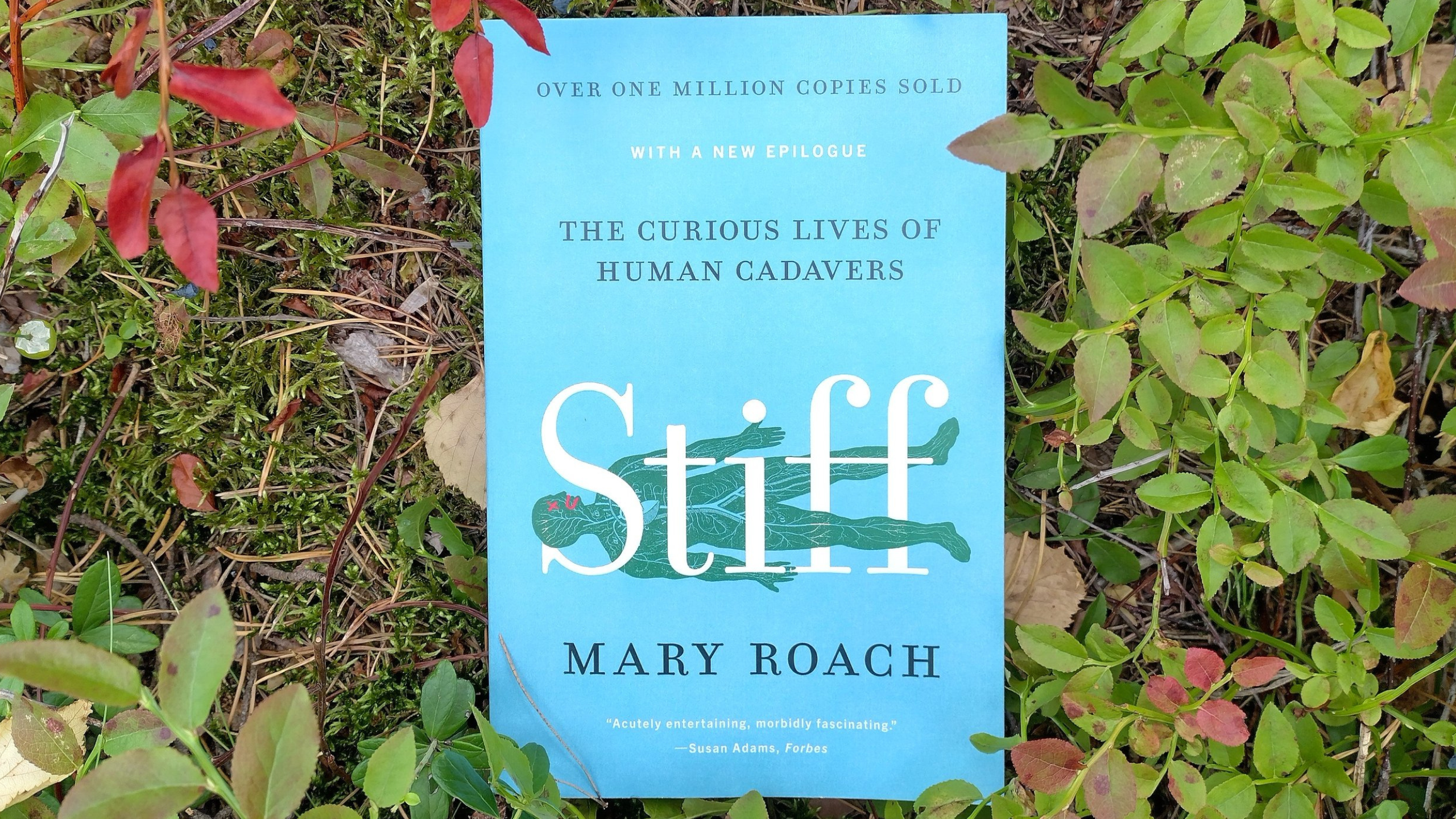
August Read: Stiff: The curious lives of human cadavers by Mary Roach
By Kathleen McLaughlin, Ed.D. | August 23, 2023
| Kathleen McLaughlin, Ed.D. is one of BioBuzz’s incredible Ambassadors of Buzz. She’s also the Philly Socializing Scientists organizer and, as a self-proclaimed bibliophile, the Queen Bee of Virtually Socializing Scientists Book Club. Every month Kathleen shares her thoughts on the [science] book of the month. Have a book rec?! Get in touch with her via LinkedIn. |
How on earth did I find this book? I know it quirks a few brows as a book club choice, but hear me out. Starting a book club for science-related books, found me in a position of realizing I don’t know where to learn about new and exciting books that are science-related non-fiction. I looked at Goodreads–a website I frequent in the hopes of discovering hidden gems, beloved favorites, as well as books and authors that I might not come across at my local bookstores. Before I devolve into a diatribe regarding independent bookstores and the joy of books in general, I will return to this book in particular. It was on one of the lists of popular science books. I read the blurb and thought it sounded interesting. Voila! August’s book was selected. (Side note: I’m open to book suggestions, so please send them my way!)
I was incredibly excited and engrossed with this book, though there were a few chapters I felt were more like swallowing too much peanut butter–hard to swallow, not pleasant, but still had some good information. You could skip a chapter if you wanted to, as it’s set up in a way that each chapter covers a different aspect and is not integrally linked together so that you would miss something important for a later chapter. My personal opinion of this book is that it’s interesting and informative, and, I think sheds light on some unsung heroes–cadavers and researchers who utilize cadavers.
When I hear the word ‘cadaver,’ my brain conjures up the image of a morgue. A wall of stainless steel doors on the wall, the floor black and white tiles that are easily wiped down, metal tables you never want to find yourself laying on, bright lights that make things feel sterile, inhuman, and cold to your bones. Perhaps, I’ve seen too many shows that feature morgues; I can easily imagine that most people find them to be uncomfortable physically and emotionally. Thinking of the dead brings forth the realization that everyone dies. It’s not comforting. No one from the beyond has come back to tell us what it’s like–it’s the great unknown that the living will never be able to study (most likely that is, since I don’t know the future or what it holds).
Most people are not exposed to death (and I’m speaking from my experience in the US). My first experience was when there was a funeral in grade school. I don’t remember who–though I think it was a parish priest for the school I attended. I vaguely recall the entire school attending the service, but not much.
Death wasn’t personal until I lost my great-grandmother, my grandmother’s best friend, and my grandfather in the span of a few months. It was brutal. I was only present for my grandfather’s death, as he was in the hospital in the ICU, and it was traumatic as a twelve-year-old. Everything was outside of the home, they were in environments designed for the dead and dying–hospitals, funeral homes, and cemeteries.
It’s a large change in culture from when my aunt was growing up. I recall my grandmother telling me the story of my great uncle, and how he passed away unexpectedly. During those years (I believe it was the 1950’s) my great-uncle was laid out in the family home. There was no coffin. I imagined him on the dining room table surrounded by flowers, but cannot confirm this to be the truth. People walked through the home for the visitation, to see him before he was interred. The highlight of the story was my aunt, who was a toddler at the time, recalls how she saw him lying there and in her toddler ways said ‘Wake up sleepyhead!’ and tried to pull his hair to wake him up. I always smile and mentally chuckle when I recall this short anecdote, probably because I can imagine a tiny version of my aunt trying to boss a cadaver around, not realizing that he was a cadaver and not her uncle.
Nowadays, we reserve death and dying for outside the family home, and it helps to explain why this book might cause people to shy away from picking it up. Allow me to share some information as to why you might want to reconsider. Because this book isn’t about death or dying, it isn’t about people. It’s about the human body–without whatever makes a human being, well-being. At this point, the human being has been and is merely a body now. No longer housing the person who once inhabited said body.
Now for the nitty gritty… some highlights, thoughts, and discussion points.
One comment during book club was that everyone dies, but hardly anyone donates their body–their cadaver–to science. After this book, I hope you consider how you can be a scientific hero, by merely willing your body to science.
Stiff blends humor, history, and science to tell the tale of how cadavers have been treated throughout history. More importantly, in my opinion, you get a chance to realize that cadavers are unsung heroes and so are the researchers who work with them. You might ask who works with cadavers? And once you learn about the different areas of research that utilize cadavers (I hope) you realize that we owe our thanks.
Picture this: You’re wearing a thin, scratchy hospital gown that opens in the back, and your feet are in socks that feel awkward on your feet. The thin padding on the gurney reminds you of the mats that were used in highschool gym class, and must be attributed to savings. The pillow under your head barely qualifies, as it’s little more than a large bag of cotton balls in a pillow-like shape. Your hair is trapped under a hair net more suited to working a serving line in the cafeteria. You’re being wheeled to the operating room for a simple appendectomy.
Now, it’s something that happens frequently in hospitals, and surgeons are well-trained. (We had a surgeon at our discussion, and he was able to walk us through the stages of surgery and reassured us that we are in competent hands). Now flash back to a time when cadavers weren’t used in anatomy labs. Do you still feel comfortable with your surgeon? With a person that hasn’t seen the inside of a human body, but rather has read about where the structures are. Well, in one part of this book, you learn about what happens to those who are treated by such doctors. I don’t know about you, but I want my surgeon to be familiar with my innards, my inner workings, and to have tried it on someone before me.
The purpose of this book is to look at how cadavers have been studied and used throughout history. Remove human essence from the human body, and think about all that we have been able to achieve–understanding the human body, organ transplants, vehicle safety, land mine removal safety, and how to solve the mystery of time of death. You will also get to learn history and cultural tidbits about cadavers. For instance, at one point in time, death was not the ultimate penalty. It wasn’t enough to threaten death for crime, you had to punish murderers with death and dissection. You’ll have to read the book to find out why!
Join us (virtually) for the next book: What If? : Serious Scientific Answers to Absurd Hypothetical Questions by Randall Munroe September 12, 2023 from 6:00pm to 8:00pm.








